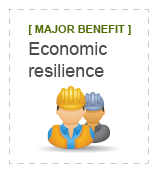Network/cluster businesses and design neighborhoods and developments to achieve better energy, social, economic and environmental outcomes in service of a more circular and equitable economy.
Best Practice
Best Practice Actions
a. Shared parking/access, electric vehicle charging for 3% of parking and/or synchronized with solar generation.
b. Green product development, manufacturing or sales OR a green job training program.
c. Buildings located within walking distance of transit and/or residential zoning.
d. Renovated buildings, buildings designed for reuse, shared recreation/childcare facilities.
e. Green buildings built to Minnesota's SB2030 energy standard OR renewable energy generated on-site.
f. Combined heat and power (CHP) generation capacity, shared geothermal heating/cooling, microgrid OR energy storage.
g. Low-impact site development.


 A biomass combined heat and power system in the Silver Bay, MN Eco-Industrial Park is estimated to increase fuel efficiency above that in utility-sized coal-fired electric power plants from about 37% to about 75%. In using wood, net CO2 emissions are zero, displacing approximately 150,000 tons per year of CO2. A 2500-kilowatt pellet plant power and district heating system, firing about 10 tons per hour of biomass, is estimated to create 15 permanent pellet plant jobs and 6 logging jobs. Estimated savings from the district heating is $200,000 when compared to using natural gas.
A biomass combined heat and power system in the Silver Bay, MN Eco-Industrial Park is estimated to increase fuel efficiency above that in utility-sized coal-fired electric power plants from about 37% to about 75%. In using wood, net CO2 emissions are zero, displacing approximately 150,000 tons per year of CO2. A 2500-kilowatt pellet plant power and district heating system, firing about 10 tons per hour of biomass, is estimated to create 15 permanent pellet plant jobs and 6 logging jobs. Estimated savings from the district heating is $200,000 when compared to using natural gas.